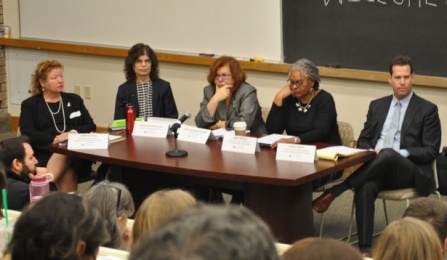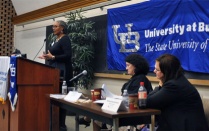Law Links - December 2016
A coordinated response to short-circuit family violence

Lynette Reda, Judith Olin ’85, Hon. Lisa Bloch-Rodwin ’85, Gwen Wright, and Daniel M. Weitz
How to stop intimate partners from hurting – even killing – each other? Lawyers, social scientists and activists have long wrestled with that difficult question. What preventive strategies and what responses can make peace in troubled families?
Some specific answers were up for discussion as the UB School of Law hosted a major conference entitled “Domestic Violence Update: Where We Were, Where We Are Now, and the Work Ahead.” Co-organized by Professor Kim Diana Connolly, vice dean for experiential and skills education, the sold-out Nov. 18 conference brought together scholars and practitioners from the fields of law, mental health, substance abuse, advocacy and dispute resolution.
Among the presenters at the day-long forum was Assistant Clinical Professor Judith Olin, who directs the School of Law’s Family Violence & Women’s Rights Clinic. She shared the dais with Lynette Reda, chief of the Domestic Violence Bureau for the Erie County District Attorney’s Office. Together they discussed the work of an innovative response to intimate partner violence: the county’s Domestic Violence High Risk Team, which takes a multidisciplinary approach in seeking to prevent homicides by identifying possible violent offenders and assessing the risks to the potential victim.
The threat, Olin said, is very real. While statewide rates of domestic violence homicide have declined, eight women were killed by their partners or other family members in 2015 – more, she noted, than in heavily populated Brooklyn and Manhattan counties.
“The ripple effects from these cases are really intense,” Olin said, citing the impact on, for example, children left without a mother, but also for the community in terms of the costs of social services, incarceration, medical care and other indirect costs.
In response, she said, the Domestic Violence High Risk Team seeks to prevent family homicides by assessing the risk to potential targets; responding with a multidisciplinary team approach; and coordinating an effort to monitor and contain offenders.
Olin went on to review some of the tools that responders can bring to bear on sometimes explosive family situations. Massachusetts, for example, allows “dangerousness hearings” for individuals accused of domestic violence; if they are judged to be an immediate threat to the partner, they can be confined during the pre-trial phase. New York, she argued, should institute such hearings: “If more offenders were confined in the immediate aftermath, women’s safety would be enhanced.”
Olin also described the use of a standardized tool called a danger assessment, developed by Dr. Jacqueline Campbell, RN, Ph.D. Responders ask a domestic violence victim questions such as whether her abuser is unemployed, whether there is a child in the home who is not his, whether he has a history of stalking, and whether she felt he was capable of killing her.
Olin described more recent updates to the tool to take into account the special risks faced by immigrant women. This is particularly relevant in our local community given the ever-increasing presence of refugees and immigrants.
Olin also acknowledged what she called “a disconnect between the domestic violence advocacy community and some in the matrimonial and family law bench and law.” As evidence, she pointed to family lawyers’ stock advice to women in marriages affected by domestic violence: if they leave the family home, they are giving the remaining spouse “a huge upper hand” in winning the house in subsequent divorce proceedings, or possibly gaining custody of any children.
“Why should she choose,” Olin said, “and why should we put her in this dilemma? As more attorneys are educated on risk assessment, I hope there will be knowledge and respect for tools like the danger assessment.”
The problem is real, but the response is determined. “We’re one of the few counties that has a high-risk team,” Olin said. “We know it’s too late for 2016, but we can all work together to make 2017 a year of zero family violence homicides in our community.”
Sponsors of the event were the New York State Office for the Prevention of Domestic Violence; the Association of Family and Conciliation Courts, New York Chapter; UB School of Law; the Family Violence and Women’s Rights Law Clinic; the UB School of Social Work; and the Office of Attorneys for Children, New York State Supreme Court, Appellate Division, Fourth Judicial Department.
